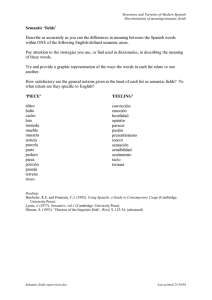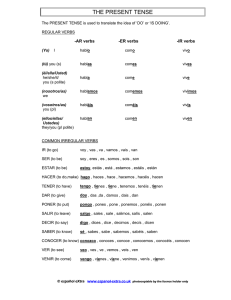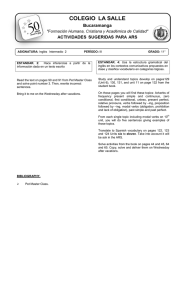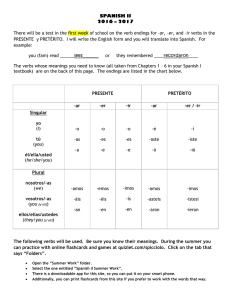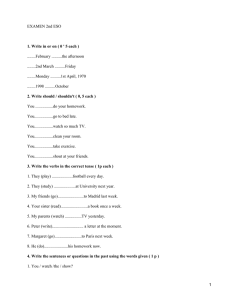Establishing Semantic Oppositions for the Typification of Predicates
Anuncio
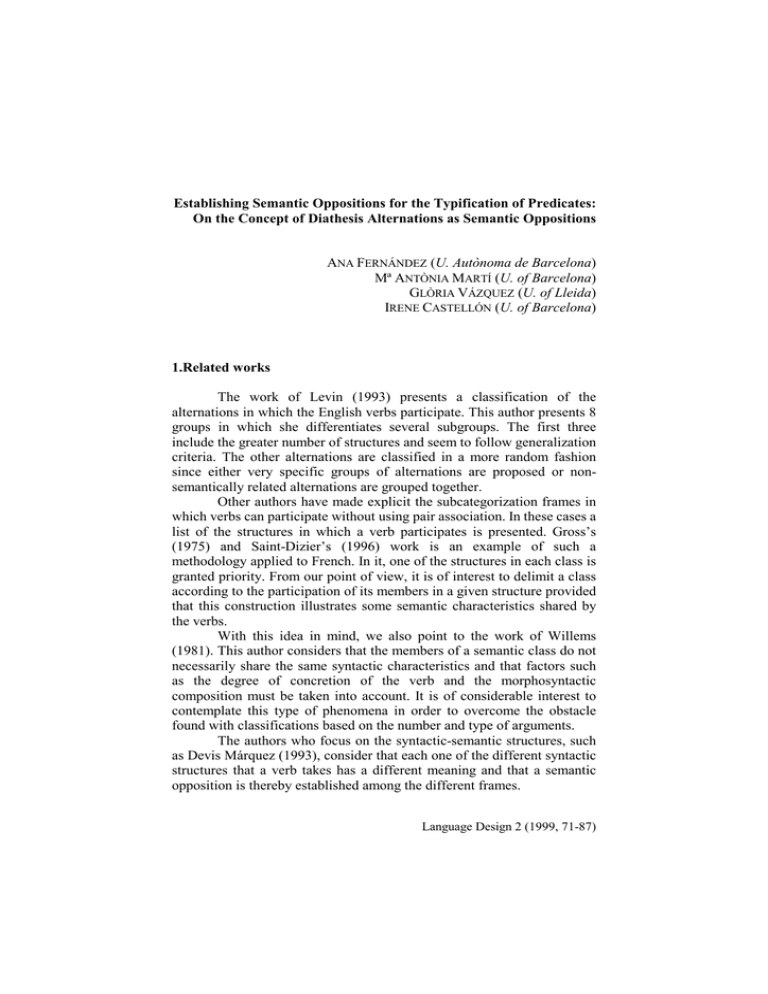
Establishing Semantic Oppositions for the Typification of Predicates: On the Concept of Diathesis Alternations as Semantic Oppositions ANA FERNÁNDEZ (U. Autònoma de Barcelona) Mª ANTÒNIA MARTÍ (U. of Barcelona) GLÒRIA VÁZQUEZ (U. of Lleida) IRENE CASTELLÓN (U. of Barcelona) 1.Related works The work of Levin (1993) presents a classification of the alternations in which the English verbs participate. This author presents 8 groups in which she differentiates several subgroups. The first three include the greater number of structures and seem to follow generalization criteria. The other alternations are classified in a more random fashion since either very specific groups of alternations are proposed or nonsemantically related alternations are grouped together. Other authors have made explicit the subcategorization frames in which verbs can participate without using pair association. In these cases a list of the structures in which a verb participates is presented. Gross’s (1975) and Saint-Dizier’s (1996) work is an example of such a methodology applied to French. In it, one of the structures in each class is granted priority. From our point of view, it is of interest to delimit a class according to the participation of its members in a given structure provided that this construction illustrates some semantic characteristics shared by the verbs. With this idea in mind, we also point to the work of Willems (1981). This author considers that the members of a semantic class do not necessarily share the same syntactic characteristics and that factors such as the degree of concretion of the verb and the morphosyntactic composition must be taken into account. It is of considerable interest to contemplate this type of phenomena in order to overcome the obstacle found with classifications based on the number and type of arguments. The authors who focus on the syntactic-semantic structures, such as Devis Márquez (1993), consider that each one of the different syntactic structures that a verb takes has a different meaning and that a semantic opposition is thereby established among the different frames. Language Design 2 (1999, 71-87) 72 A. Fernández, M.A. Martí, G. Vázquez, I. Castellón With regard to the representation of information, NLP oriented formalisms usually include information about the subcategorization required by the verb. It can be shown by declaring the list of structures in which the verb participates (Sager 1981), or these structures can also be generated from one frame as is the case of the LFG (Kaplan & Bresnan 1982), GPSG (Gazdar et al. 1985), and HPSG (Pollard & Sag 1987). We propose that given a type hierarchy of verb entries, the rules that account for syntactic behavior regarding alternations have to be associated to the representative type of a verb group in order to express interesting linguistic generalizations. In these types, the participation of a set of verbs in a particular alternation and the mechanism required to express it must be specified. Works carried out along these lines are those of Sanfilippo (1990) and Taulé (1995) within the Acquilex project. 2. Model of lexical entry Our initial hypothesis is that the syntax and the semantics of lexical items are interrelated (Levin & Pinker 1991, Levin 1993, Levin & Rappaport 1995). These authors consider that verbs can be semantically classified based on the meaning they share. The hypothesis is that the verbs of a semantic class will share the same syntactic behavior. Hence, each semantic class is associated with the constructions in which the verbs of that group participate. In our approach, we consider that relevant semantic information can be deduced from the syntactic behavior. Thus, our semantic analysis includes a syntactic study of the subcategorization frames in which different verbs can be found. For this reason, in contrast to the above mentioned authors, we do not infer syntactic behavior from the semantic characterization but rather it is syntax that helps us to complete this semantic description. We also consider that this relation can be formalized and that it is essential for the characterization of the entries. The three elements around which the information that makes up the verbal lexical entry is organized are: meaning components, event structure and diathesis alternations. With regard to meaning components, we draw principally from Talmy (1985). According to this author, these components play a central role in defining verbal semantic classes. In our approach we have defined a small group of semantic components that we have organized into several levels. The levels range from the more general to the more specific. The first level is common to all the predicates and accounts for Entity. The second level serves us to Establishing Semantic Oppositions... 73 distinguish events from states: only the first ones can have an Initiator. At a third level we specify those components relevant for grouping verbs into semantic classes: Change, Attitude, Transference, etc. The components considered at a more specific level allow us to characterize predicates, but not to define new classes: Instrument, etc. From the standpoint of realization, they can be expressed in the lexical item1 (e.g. La pared se desplomó / The wall crashed) or else syntagmatically (e.g. El príncipe se transformó en rana / The prince turned into a frog) . As concerns event structure, we follow Parsons’ (1990) and Pustejovsky’s (1995) works. These authors consider that an event can be decomposed into a subatomic structure in which the temporal relations established between the subevents and the participants are described. In this sense, several patterns of eventual behavior have been established. They interact with the other elements that constitute our model. Finally, our model presents information about diathesis alternations. This is the subject of this paper and acts as the basis for the verb classification we present here. We have formalized this information in the Pirápides Lexical Knowledge Base (PLKB) in the form of modules. In it, the types corresponding to each one of the modules that form the entry have been made explicit. Also, the diathesis alternations have been dealt with as lexical rules. An extra module, FORLOG, has been defined to account for the relation between semantics and syntax, connecting all the information to be found. 3. Concept and typology of diathesis alternations Our starting point for the study of alternations is Levin’s (1993) work. Unlike this author, we think that it is important to take into account only those very general alternations (middle, causative-inchoative…), that explain relevant syntactic behavior and that really highlight the relation between syntax and semantics. Those constructions that are very specific and in which very few verbs participate, such as Obligatory Adverb (8.5), have been left aside. In our proposal we understand diatheses as one of the syntagmatic expressions of a semantic opposition. Diathesis alternations are thus pairs of structures (or diatheses) related to each other by one of these oppositions. We have considered the existence of three possible 1 By means of lexicalization, incorporation or else it can be understood. 74 A. Fernández, M.A. Martí, G. Vázquez, I. Castellón oppositions depending on whether there is a change of focus in the participants (Change of focus and Underspecification) or there is a change in the event structure (Aspectual Opposition). For example, the sentences: (1) a. Elena cerró la puerta a. Elena closed the door b. La puerta se cerró b. The door closed are related by a change of focus opposition: whereas in (a) the cause that provokes the event is expressed, in (b) the change undertaken by the entity is focalized. On the other hand, sentences such as: (2) a. Juan comió pescado a. Juan ate fish b. Juan comió b. Juan ate are related by means of an underspecification opposition of (b) with respect to (a). Lastly, the aspectual opposition is illustrated in the following examples in which an event (a) is related with a state (b): (3) a. Sara pinta un retrato a. Sara is painting a portrait b. Sara pinta muy bien b. Sara paints very well We start from the hypothesis that these oppositions are general and interlinguistic in nature and that, therefore, the corresponding syntagmatic realizations in each language have to be defined. It is thus possible to establish translation relations between the languages at a semantic level and for each meaning opposition it will thereby be feasible to predict the syntactic structures that can express it. For example, Basque incorporates the cause by means of a morphological process as can be seen in the examples below: (4) a. Kanpaiak jo du a’. The bell rang b. Apaizak kanpaiari joarazi dio b’. The priest rang the bell Whereas in other languages, such as Spanish and Catalan, we need a causative auxiliary verb to express the same information (5) a. La campana sonó (Sp) / La campana va sonar (Cat) b. El cura hizo sonar la campana (Sp) El capellà va fer sonar la campana (Cat) Establishing Semantic Oppositions... 75 As can be seen (4a’,b’), in English neither the morphological process nor the auxiliary verb are needed. Diathesis alternations in our approach can be expressed in three ways: in the same lexical item (cut, break), by means of morphological processes (aburrir/aburrirse) or by composition (bore /get bored). In the following section, we present our typology of oppositions in greater detail. They are grouped into two classes. In the first one, Class A, the opposition is between two eventive structures while in the second, Class B, the opposition is between an event and a state: A. OPPOSITION EVENT-EVENT 1. CHANGE OF FOCUS. this opposition implies a change of perspective in the subcategorized elements.2 The first subtype (1.1) is an alternation between the expression or the non-expression of the cause. The second (1.2) is an opposition in which there is an interchange of arguments at a syntactic level without any loss of semantic information. Finally, in the third subgroup (1.3) there is a change in the focalization of the components of a single argument which is semantically complex. 1.1 CAUSE. One of the alternating structures is causative, i.e. the cause is expressed in the constituent that occupies the subject position. In the other structure, the anticausative, the change undertaken by the entity is focalized and it moves to the subject position; the cause is usually left unexpressed. In this type of opposition, a similar change occurs in the focalization of the event head: in the causative structure the process is focalized and in the anticausative it is the resulting state. As we have said, we consider that this information can be realized in several ways. The frames specified below are valid for all the languages involved in this study. We also state the corresponding event structure:3 2 We include the subject in the subcategorization list. Tables have to be interpreted as follows: the basic structure is declared in the first cell of SUB, the numbers associated to the syntactic category correspond to the order of appearance of constituents. In the second cell we mantain this numbering. The indexes associated to the examples make reference to the number declared in each one of the frames stated in SUB. A translation for the Spanish examples is provided in Appendix A. 3 76 A. Fernández, M.A. Martí, G. Vázquez, I. Castellón CAUSE SUB 1) NP1 V [NP2 (prep+NP3)] ANTICAUSE 1a) NP2 (pron) V (PP[prep+NP1]) 1b) NP2 aux V (PP[prep+NP1]) 2a) NP2 V (PP[prep+NP1]) 2b) NP2 aux. V (PP[prep+NP1]) EXAMPLES 1) La subida de precios ha variado la 1) Pedro ha arrugado el papel bolsa 1b) El papel ha sido arrugado (por 1a) La bolsa ha variado (por la subida Pedro) de precios) 2) El cura hizo sonar la campana 1) El calor ha fundido el hielo 2a) La campana sonó 1a) El hielo se ha fundido (a causa del calor) 2) The news made John happy 2b) John was happy (with the news) 2) NP1 aux. + V NP2 1.2 INVERSE. These are simple event structures that express the same event from two different perspectives implying an argument switch. They involve two participants that become the focus of attention in each alternating structure.4 FOC. PART1 SUB 1) NP1 V NP2 FOC. PART2 1a) NP2 V (PP[prep+NP1]) EXAMPLES 1) El sol irradia calor 1a) El calor irradia del sol 1.3 HOLISTIC. With the term holistic we refer to an opposition between a structure that presents an entity as a whole and another construction in which the emphasis is placed on one of its constitutive parts. We understand this type of metonymical relation in a broad sense, including as parts the instruments, the means, the properties, the contents, etc. In this case, the possible combinations of the syntactic alternation is considerable. The switch can be within the verb phrase or within the subject and complement positions. There might be either a loss of information or only a change in the distribution of the participants. 4 Parallelisms can be observed with verbs of the type comprar/vender (buy/sell) or dar/recibir (give/receive) in which a third participant is implied. In such cases a different lexical item is required for the inversion. Establishing Semantic Oppositions... 77 SUB WHOLE 1) NP1 V (NP2) prep+NP3 PART 1a) [NP3 (PP[prep+NP1])] V (NP2) 1b) NP1 V NP3 PP[prep+NP2] 1c) NP1 V [NP3 PP[prep+NP2]] 2) NP1 pl pron pl V pl 2a) NP1’ pron V PP[prep+NP1’’] 2b) NP1’ V NP1’’ 3) NP1 V (NP2) NP3 3a) NP1 V (NP2) PP3’ PP3’’ EXAMPLES 1) El vigilante abrió (la puerta) con 1) Irene critica a Lola por su egoismo la llave maestra 1c) Irene critica el egoismo de Lola 1a) La llave maestra (del vigilante) abrió (la puerta) 2) Ana y Esther se encontraron 2a) Ana se encontró con Esther 1) Las pirámides maravillaron (a los 2b) Ana encontró a Esther turistas) por su magnitud 1a) La magnitud de las pirámides 3) Los niños cruzaron el río maravilló (a los turistas) 3a) Los niños cruzaron de una orilla a la otra 1) El mozo cargó el camión con patatas 1b) El mozo cargó patatas en el camión 2. UNDERSPECIFICATION. Cases of argument elision without any switch in the argument position are included here. The omission of these arguments is possible when the information is not considered relevant for communicative purposes or it is provided by other elements of the discourse that are of a pragmatic or spatio-temporal nature. 78 A. Fernández, M.A. Martí, G. Vázquez, I. Castellón SUB SPECIFIC 1) NP1 V (NP2) PP1 PP2 GENERAL 1a) NP1 V (NP2) 1b) NP1 V PP1/PP2 1c) NP1 V PP1 PP2 2) NP1 V (NP2) PP1 2a) NP1 V (NP2) 3) NP1 V (NP2) NP3 3a) NP1 V (NP2) EXAMPLES 1) El mensajero corrió desde su casa 2) El preso huyó de la prisión hasta el pueblo vecino 2a) El preso huyó 1a) El mensajero corrió 2) El trabajador descargó las cajas del 1) El obrero subió los ladrillos desde camión la planta baja hasta el último piso 2a) El trabajador descargó las cajas 1a) El obrero subió los ladrillos 3) Pedro bajó las escalera 1) María partió de su ciudad hacia 3a) Pedro bajó un nuevo destino 1b) María partió de su ciudad 3) Juan movió la mesa unos 1b) María partió hacia un nuevo centímetros destino 3a) Juan movió la mesa 1) Miguel condujo el coche desde Barcelona hasta Tarragona 1c) Miguel condujo desde Barcelona hasta Tarragona The four alternations seen so far (1.1, 1.2, 1.3, 2) respond to a different vision of the action. In the table below, we show the different aspects of the sentence that can be altered: different focus, different number of arguments subcategorized (SUB), and information loss. In the first place, we can modify the information involving the topic of the sentence when we apply one of the first three oppositions. Secondly, there can also exist a change in the number of elements contained in the subcategorization frame. And finally, and somehow related to the previous point, in some oppositions some information (meaning components) can be lost. Establishing Semantic Oppositions... 79 Cause Inverse + + + - Different +/number of SUB - + + Information loss - - + Different focus +/- Holistic Underspec. B. ASPECTUAL OPPOSITION This opposition implies the alternation of an eventive predicate with a stative one. An eventive predicate can become stative when the tense is not marked, in which case it is also usually accompanied by a modifier. In this type of alternation the switch of arguments is possible. In the following examples (6) there is no switch and we are predicating about a property of the first argument: (6) a. María bailó el tango a’. María danced the tango b. María baila el tango (muy bien) b’. María dances the tango very well (event) (state) It seems that all the events can be transformed into a state when the conditions previously mentioned are fulfilled. The construction known as middle is included in this group too. This structure is participated by those transitive predicates that allow argument switch and that require an adverbial modifier to express the manner in which a property of the entity is being affected. (7) a. Mi madre cortó la carne a’. My mother cut the meat b. La carne se corta con facilidad b’. The meat cuts easily (event) (state) Lastly, the construction known as adjectival passive: estar+participle combines with a transitive construction to express the same sort of opposition: 80 A. Fernández, M.A. Martí, G. Vázquez, I. Castellón (8) a. El niño ha roto el juguete (event) a’. The child has broken the toy b. El juguete está roto (state) b’. The toy is broken In short, our proposal for diathesis alternations is based on establishing generalizations that allow us to characterize groups of syntactic constructions that provide semantic criteria for verb analysis. We have presented in this section three semantic alternations that we have considered so far: change of focus (cause, inverse and holistic), underspecification and aspectual opposition. This proposal has allowed us to classify verbs into semantic classes according to the semantic opposition in which they participate. Also, they can be further subclassified according to criteria regarding event structure and subcategorization. In the next section we present the result of such grouping. 4. Resulting classes We have grouped about 4.000 verbs (1.350 in each language approximately)5. This grouping has been made according to the shared characteristics which define the behavior of the predicates. The classes defined so far are: Predicates of Change (800 predicates), Predicates of Attitude (200 predicates) and Predicates of Transference (350 predicates). Not all the verbs behave homogenously within each group. This is the reason why we have further subdivided them according to protobehaviors. This approach shows a more general and consistent classification. More general because we have grouped 1.350 verbs belonging to 20 Levin classes into just three classes; more consistent in the sense that we have applied the same criteria in defining all of them. As can be seen in table below, classes share the same meaning components, two of which, the initiator and the entity, are also shared by the members of the three groups since all of them denote an event. Furthermore, each class can present the same event structure and the same basic diathesis alternations as well. 5 We have available an LDB containing the translation equivalences in Catalan, Spanish and English for all these verbs linking them to Levin' s semantic classes and to the new classes we propose in this paper. Establishing Semantic Oppositions... 81 CLASS Meaning components Event Structure Semantic opposition Number CHANGE ATTITUDE Entity/Initiator Change e1:event e2:resulting state e1* < e2* Antic. (ch. focus) Aspectual opposition1 800 Attitude e1:event Holistic (ch. focus) Passive (ch. focus) TRANSFERENCE Transference e1:event e2: state e1* REL e2* Underspecification 200 350 As we have mentioned, these groups are subdivided according to more specific syntactic and/or semantic criteria. In the tables below we provide for each class the distinctive features, the subclasses with their defining elements, and the actual predicates to illustrate them. In the case of the verbs of change, two basic types are observed (change 1 and change 2) depending on whether the expression of the component change is made lexically or it is expressed as a different constituent. Predicates of change Subclass Change 1 Change 2 Subcat NP V NP NP V NP PP lexical/incorp Syntactic Example romper/to break convertir/to convert Number 796 4 MC. Realization In the case of verbs that express an attitude or feeling, two groups are also observed (attitude1-2 and attitude 3) if we take into account the subcategorization and the kind of realization of the meaning component specific to the class. If we consider event structure the first group splits into two (attitude 1 and attitude 2). The type of event expressed by the verbs that we are dealing with can also be simple or complex. The verbs of attitude that have a complex event structure express two processes. We thus differentiate between verbs that express a simple mental process (desear-desire) from those that also denote another action (complex events). This other action can be of a communicative type (criticar-criticize) or of a different kind (reír delaugh at). 82 A. Fernández, M.A. Martí, G. Vázquez, I. Castellón Predicates of Attitude Subclass Attitude 1 Attitude 2 Attitude 3 Subcategorization NP V NP NP V NP AP MC Realization Lexical/incorp syntactic ES e1: event e1: event e2: event e1*=e2* e1: event Example admirar/to admire 146 criticar/to criticize considerar/to consider 16 Number 79 Finally, when dealing with verbs of transference we find that their subcategorization presents a very diverse casuistry. It depends on whether the verb can express syntactically the points of the trajectory (ir de un sitio a otro-go from one place to another) or only one of them (poner una cosa en un sitio *(desde otro) - put something in a place (from another)); or if it can express a transference carried out autonomously by the entity (correr-run) or it cannot (dar-give). The combination of these factors give rise to four subgroups that we state next: Predicates of Transference Subclass Transference 1 Transference 2 Subcat NP V PP1 PP2 NP1 V NP2 PP1 PP2 MC Realization syntactic(incorporation) Number 60 40 Example ir/to go transportar/to transport Subclass Transference 3 Transference 4 NP V PP NP1 V NP2 PP Subcat MC Realization syntactic Number 35 212 Example Llegar/to arrive poner/to put Establishing Semantic Oppositions... 83 5. Implementation The generalizations obtained at a theoretical level, both for the classes as well as for the subgroups defined according to the observed behaviors, have been reflected in an LKB. To that end, we have designed a type hierarchy to take into account the universe that we want to describe. Each verb is ascribed to a type that contains information shared by the group. This allows the task of entering data to be economized without any loss of information and takes into account the characteristics shared by sets of verbs. The hierarchy contains two basic types: utiles and entry. Utiles subsumes all the objects that are used for the description of the basic elements in the entry: meaning components, diathesis alternations, and event structure. In each case, the basic elements are declared: the three types of diathesis alternations, the list of components and the types of events (the temporal relation established between them and the head). Entry includes two subtypes to account for the simple and complex structures declared and, for each case, subtypes are defined for the verbal classes (entry-type-change1, entry-type-change2...). In these types, the syntactic-semantic information shared is declared. Thus, for instance, the verb sorprender (to surprise) that belongs to the class of verbs of change 1 is assigned the type entry-type-change1: sorprender entry-type-change1 <morf> = sorprend-/M3 <syntax: subcat: compl semref> = all <syntax: subcat. restcomp: compl: semref> = animate As can be seen, at the lexical level only idiosyncratic information is specified, i.e. morphology and selectional restrictions, whereas the data about meaning components, event structure and alternations is obtained through mechanisms of inheritance from the assigned type. In the specification of the alternations, an attribute is included for each one (DIATVAL). It serves to indicate whether the verb participates in the construction and when it does it expresses the procedure required by the verb to convey the meaning (lexical, syntactic or morphological). From this information a lexical rule can be applied and a new entry 84 A. Fernández, M.A. Martí, G. Vázquez, I. Castellón generated. We can illustrate this with the anticausative rule (change of focus) for the verbs of change such as romper: DIAT: FOC-CHANGE: ANTICAUSATIVE: DIATVAL: diatrue D-LEX: string D-SINT: string D-MORF: true The activated rule generates a new entry, romperse, modifying some data of the input entry. The following table exemplifies the information that is altered: Entry Orthography MC Realization SUB Event Structure Acceptance of alternation INPUT complex simple 2 syntag., 1 incorp. 2 head e1 yes OUTPUT Complex Complex 1 syntag., 1 incorp., 1 under. 1 head e2 No The inclusion of all this information in an LKB has permitted us to check the adequacy of the theoretical framework and to evaluate the possibilities of formalizing it. 6. Conclusions The model of lexical entry provides explicit criteria for the analysis of the predicates. The application of these criteria allows us to make manifest relevant generalizations about verbal behavior regarding event structure, meaning components, and diathesis alternations. In this paper we have proposed a typology of alternations according to the semantic opposition they denote. This approach allows us to deal with the multilingual transfer problem and to account for a series of verb centered mismatches: Spanish, Catalan and English show different mechanisms for the expression of the meaning conveyed by the alternations. Establishing Semantic Oppositions... 85 The study of alternations, together with the meaning components and event structure, has permitted us to group the predicates analyzed up to the present in three classes: Change, Attitude and Transference. Each one of them is exemplified with a different casuistry and diverse degrees of homogeneity. This fact has taken us to the definition of subclasses according to their behavior with respect to one or more of the before mentioned elements. In the PLKB, mechanisms have been applied for the inheritance of these behaviors in a general and economical manner. Currently, we are working on transferring the data contained in the LKB into an LDB since it allows easier and faster access to the information. The final aim is the integration of several resources available onto a platform that incorporates and relates different components for the analysis of textual sources. References Devis Márquez, P. (1993) Esquemas sintáctico-semánticos, Cádiz: Universidad. Gazdar , G., E. Klein, G. Pullum, I. Sag (1985) Generalized PhraseStructure Grammar, Oxford: Blackwell. Gross, M. (1975) Méthodes en Syntaxe, Paris: Hermann: Kaplan, R.& J.Bresnan (1982) Lexical-Functional Grammar: A Formal System for Grammatical Representation, in The Mental Representation of Grammatical Relations, Cambridge (Mass.): The MIT Press. Levin, B. (1993) English Verb Classes and Alternations, Chicago: University Press. Parsons, T (1990) Events in the Semantics of English, Cambridge (Mass.): The MIT Press. Pollard, C. & I. Sag (1987) Head-Driven Phrase Structure Grammar, Chicago: University Press. Pustejovsky, J. (1995) The Generative Lexicon, Cambridge (Mass.): The MIT Press. Sanfilippo (1990) Grammatical relations, Thematic Roles and Verb Semantics, Ph Dissertation, University of Edimburgh. Sager, N. (1981) Natural Language Processing, Addison-Wesley, Reading Mass. Talmy, L. (1985) Lexicalization Patterns, in Shopen (ed.), Language Typology and Syntactic Description, Cambridge: University Press. 86 A. Fernández, M.A. Martí, G. Vázquez, I. Castellón Taulé, M. (1995) Representación verbal en una Base de Conocimiento Léxico, Ph.D., Barcelona. Willems, D. (1981) Syntaxe, lexique et sémantique, Gent Uitgeverig Universa. Appendix A6 Opposition event-event (page 4 - table) 1) The rise in prices has affected the stock exchange 1a) The stock exchange has been affected (by the rise in prices) 1) The heat has melted the ice 1a) The ice has melted 1) Pedro crumpled the paper 1b) The paper was crumpled 2) His remark embarrassed Mary 2a) Mary was embarrassed (by his remark) 2) The priest rang the church bell 2a) The church bell rang Holistic (page 5 - table) 1) The watchman opened the door with his master key 1a) The master key opened the door 1) The pyramids impressed the tourists because of their size 1a) The size of the pyramids impressed the tourists 1) The worker loaded the truck with potatoes 1b) The worker loaded potatoes on the truck 1) Irene criticizes Lola because of her selfishness 1c) Irene criticizes the selfishness of Lola 2) Ana and Ester met 2a) Ana met with Ester 2b) Ana met Ester 3) The children crossed the river 3a) The children crossed the river from one bank to the other Underspecification (page 5 - table) 1) The messenger ran from his house to the neighboring town 1a) The messenger ran. 6 A translation for the examples in the text is provided in this appendix, as we have stated in footnote 1. Establishing Semantic Oppositions... 87 1) floor 1a) 1) 1b) 1b) 1) 1c) 2) 2a) 2) 2a) 3) 3a) 3) 3a) The worker took the bricks from the ground floor up to the top The worker took the bricks up María parted from her city to a new destination María parted from her city Mary parted to a new destination Miguel drove his car from Barcelona to Tarragona Miguel drove from Barcelona to Tarragona The prisoner escaped from prison The prisoner escaped The worker unloaded the boxes from the truck The worker unloaded the boxes Pedro went down the staris Pedro went down Juan moved the table a few centimeters Juan moved the table
